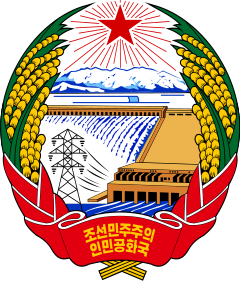Central Bank of the Democratic People's Republic of Korea
 Emblem of North Korea | |
| Headquarters | 58-1 Mansu Dong, Sungri Street, Central District, Pyongyang[1] |
|---|---|
| Coordinates | 39°01′39″N 125°45′17″E / 39.02750°N 125.75472°E / 39.02750; 125.75472[2] |
| President | Kim Chon-gyun |
| Central bank of | Democratic People's Republic of Korea |
| Currency | North Korean won KPW (ISO 4217) |
| Central Bank of the Democratic People's Republic of Korea | |
| Chosŏn'gŭl | 조선민주주의인민공화국중앙은행 |
|---|---|
| Hancha | 朝鮮民主主義人民共和國中央銀行 |
| Revised Romanization | Joseon Minjujueui Inmin Gonghwaguk Jungang Eunhaeng |
| McCune–Reischauer | Chosŏn Minjujuŭi Inmin Konghwaguk Chungang Ǔnhaeng |
The Central Bank of the Democratic People's Republic of Korea is North Korea's central bank. Established on December 6, 1947, it issues the North Korean wŏn. The Bank is subordinated to the Cabinet of North Korea.
Its president since 2014 is Kim Chon-gyun.[3] He was preceded by Paek Ryong-chon since 2011.[4]
History
On February 15, 1946, a central bank of North Korea was announced, which was to be under the control of the Soviet military.[5] However, the bank failed to accomplish its objectives, being unable to meet its costs of operation, and the 100 million wŏn capitalisation was ineffective.[6] The North Korean Interim People's Committee did not look upon the bank favorably, and chose instead to work through the Farmers' Bank, which also existed at the time.[6] By late 1946, banking functions were consolidated into two main institutions, the Central Bank and Farmer's Bank. In June 1947, around 1,000 million wŏn was concentrated in the Central Bank, allowing it to extend credits totalling 900 million wŏn for economic rehabilitation.[7] The consolidation reflected a return to the original objectives of the People's Committee, which wanted closer control over the economy; any banking people opposed to the changes within the system were removed from their posts.[7] On December 6, 1947, a comprehensive program of currency reform was announced.
In 1959, the Central and Farmers' banks were merged to form the Central Bank of the Democratic's People's Republic of Korea. The Foreign Trade Bank was established to handle the Central Bank's international business.[8]
The Central Bank has over 220 branches.[8] It operates the Chŏnsŏng electronic cash card.[9]
See also
- List of banks in North Korea
References
^ Martino, John, ed. (2013). Worldwide Government Directory with Intergovernmental Organizations 2013. Los Angeles: Sage Reference. p. 892. ISBN 978-1-4522-9937-2..mw-parser-output cite.citation{font-style:inherit}.mw-parser-output .citation q{quotes:"""""""'""'"}.mw-parser-output .citation .cs1-lock-free a{background:url("//upload.wikimedia.org/wikipedia/commons/thumb/6/65/Lock-green.svg/9px-Lock-green.svg.png")no-repeat;background-position:right .1em center}.mw-parser-output .citation .cs1-lock-limited a,.mw-parser-output .citation .cs1-lock-registration a{background:url("//upload.wikimedia.org/wikipedia/commons/thumb/d/d6/Lock-gray-alt-2.svg/9px-Lock-gray-alt-2.svg.png")no-repeat;background-position:right .1em center}.mw-parser-output .citation .cs1-lock-subscription a{background:url("//upload.wikimedia.org/wikipedia/commons/thumb/a/aa/Lock-red-alt-2.svg/9px-Lock-red-alt-2.svg.png")no-repeat;background-position:right .1em center}.mw-parser-output .cs1-subscription,.mw-parser-output .cs1-registration{color:#555}.mw-parser-output .cs1-subscription span,.mw-parser-output .cs1-registration span{border-bottom:1px dotted;cursor:help}.mw-parser-output .cs1-ws-icon a{background:url("//upload.wikimedia.org/wikipedia/commons/thumb/4/4c/Wikisource-logo.svg/12px-Wikisource-logo.svg.png")no-repeat;background-position:right .1em center}.mw-parser-output code.cs1-code{color:inherit;background:inherit;border:inherit;padding:inherit}.mw-parser-output .cs1-hidden-error{display:none;font-size:100%}.mw-parser-output .cs1-visible-error{font-size:100%}.mw-parser-output .cs1-maint{display:none;color:#33aa33;margin-left:0.3em}.mw-parser-output .cs1-subscription,.mw-parser-output .cs1-registration,.mw-parser-output .cs1-format{font-size:95%}.mw-parser-output .cs1-kern-left,.mw-parser-output .cs1-kern-wl-left{padding-left:0.2em}.mw-parser-output .cs1-kern-right,.mw-parser-output .cs1-kern-wl-right{padding-right:0.2em}
^ "North Korea Uncovered Version 18". North Korean Economy Watch. 25 June 2009. Retrieved 4 February 2017.
^ "State leadership bodies elected". The Pyongyang Times. 12 April 2014. Retrieved 3 December 2017.
^ "North Korean Economy Watch & Central Bank".
^ McCune, George M. (2007). Korea Today. READ BOOKS. p. 193. ISBN 978-1-4067-2764-7.
^ ab McCune, 2007, p. 194.
^ ab McCune, 2007, p. 195.
^ ab Hoare, James; Pares, Susan (2005). A political and economic dictionary of East Asia. Routledge. p. 31. ISBN 978-1-85743-258-9.
^ Frank, Ruediger (6 April 2017). "Consumerism in North Korea: The Kwangbok Area Shopping Center". 38 North. U.S.-Korea Institute, Johns Hopkins University School of Advanced International Studies. Retrieved 10 April 2017.
This Asian bank-related article is a stub. You can help Wikipedia by expanding it. |
This article about a North Korean company is a stub. You can help Wikipedia by expanding it. |

Comments
Post a Comment